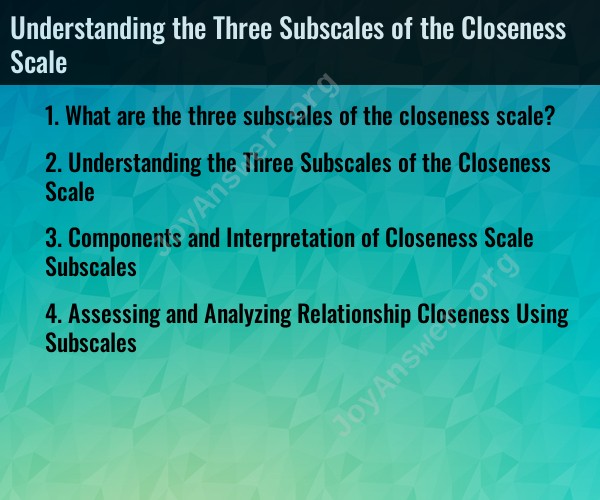What are the three subscales of the closeness scale?
The three subscales of the closeness scale are:
- Frequency - Measures how often two people interact with each other. This includes things like how often they see each other, talk on the phone, text, etc. A higher frequency score indicates more interaction between the two people.
- Diversity - Measures the variety of activities two people engage in together. This refers to doing different things together like going to dinner, movies, sporting events, etc. A higher diversity score shows the two people do many different things together.
- Strength of Influence - Measures the impact the people have on each other's behavior and decisions. A higher strength of influence score suggests the two individuals have a strong effect on each other's thoughts, feelings, and actions.
In summary, the three subscales are frequency, diversity, and strength of influence. They assess interaction quantity, variety of shared activities, and mutual impact on each other. Together they provide an overall measure of closeness in a relationship.
Understanding the Three Subscales of the Closeness Scale
The Closeness Scale is a psychological measure that assesses the level of closeness in a relationship. It is a self-report questionnaire that is typically administered to both partners in a relationship. The scale consists of three subscales:
- Intimacy: This subscale measures the degree of emotional intimacy in the relationship. It includes items such as "I feel comfortable sharing my deepest thoughts and feelings with my partner" and "I feel like I can always be myself around my partner."
- Passion: This subscale measures the intensity of romantic feelings in the relationship. It includes items such as "I am physically attracted to my partner" and "I feel like I am in love."
- Commitment: This subscale measures the level of commitment in the relationship. It includes items such as "I see myself spending the rest of my life with my partner" and "I am willing to make sacrifices for my relationship."
Components and Interpretation of Closeness Scale Subscales
Here is a more detailed overview of the components and interpretation of each closeness scale subscale:
Intimacy
The intimacy subscale measures the degree to which partners feel emotionally close to each other. It includes components such as:
- Self-disclosure: Partners feel comfortable sharing their deepest thoughts and feelings with each other.
- Acceptance: Partners feel accepted and understood by each other.
- Trust: Partners trust each other implicitly.
- Support: Partners feel supported by each other through thick and thin.
A high score on the intimacy subscale indicates that partners have a deep emotional connection. They feel comfortable sharing their inner selves with each other and they feel accepted and supported by each other.
Passion
The passion subscale measures the intensity of romantic feelings in the relationship. It includes components such as:
- Physical attraction: Partners are physically attracted to each other.
- Romantic feelings: Partners feel deeply in love with each other.
- Sexual desire: Partners have a strong sexual attraction to each other.
A high score on the passion subscale indicates that partners have a passionate and romantic relationship. They are physically and emotionally attracted to each other and they have a strong sexual desire for each other.
Commitment
The commitment subscale measures the level of commitment in the relationship. It includes components such as:
- Shared goals: Partners have shared goals for the future.
- Willingness to sacrifice: Partners are willing to make sacrifices for the sake of the relationship.
- Exclusive commitment: Partners are committed to each other and only to each other.
A high score on the commitment subscale indicates that partners are deeply committed to each other and to their relationship. They have shared goals for the future, they are willing to make sacrifices for the sake of the relationship, and they are committed to each other exclusively.
Assessing and Analyzing Relationship Closeness Using Subscales
The Closeness Scale subscales can be used to assess and analyze relationship closeness in a number of ways. For example, the subscales can be used to:
- Identify areas of strength and weakness in the relationship: Partners can compare their scores on the subscales to identify areas where their relationship is strong and areas where it could improve.
- Track changes in relationship closeness over time: Partners can retake the Closeness Scale at regular intervals to track changes in their relationship closeness over time. This can be helpful for identifying potential problems in the relationship early on and taking steps to address them.
- Compare relationship closeness to other relationships: Partners can compare their scores on the Closeness Scale to the scores of other couples to see how their relationship compares. This can be helpful for understanding how their relationship closeness is relative to other relationships.
The Closeness Scale subscales are a valuable tool for assessing and analyzing relationship closeness. They can be used by partners to identify areas of strength and weakness in their relationship, track changes in relationship closeness over time, and compare relationship closeness to other relationships.











